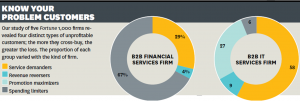BIA/Kelsey’s Local Commerce Monitor of SMBs shows that in our core sample (up to 100 employees, no minimum ad spend level), the number of marketing media used for advertising and promotion is on a path to double in 2013. The trend in our annual survey series shows the number of media used increased from 3.0 media in 2007 to 5.8 media in 2012. Digital sales teams are helping to drive this demand and sell ever larger bundles of marketing options. Indeed, in one example we’ve noted previously, DexOne CEO Alfred Mockett made it clear that bundles are central to Dex’s hopes of arresting its revenue declines.

Here’s a question to consider, “is it smart to drive higher ARPU by training sales forces to push cross selling of marketing products and services?” The answer is “yes” – sometimes. Essentially, the issue is that while cross selling may indeed increase average ARPU, there may be significant collateral damage in attracting unprofitable clients who may constrain overall revenue and profitability and drain sales and product support teams.
The Dark Side of Cross-Selling is a trap companies can fall into when they are seeking to maximize sales force efficiency; drive revenue and profit growth by up selling customers into bundles. According to research published in this month’s Harvard Business Review, companies may instead find these sales practices lead to the acquisition of unprofitable and distracting customers.
Looking at data from five Fortune 1000 companies, Professors Shah and Kumar concluded that cross selling strategies can lead to four distinct types of unprofitable customers that require different strategies by sales and product managers: Service Demanders (overuse customer service), Revenue Reversers (cost more than they spend), Promotion Maximizers (only buy discounted promotions driving revenue loss); and Spending Limiters (allocate the same spend across more products).
 Their research included two B2B firms (financial services and IT services) and three retail firms (bank, catalog and fashion).In the graphic to the right, we can see that for the customers identified as unprofitable for B2B Financial Services and B2B IT Services firms, Spending Limiters ranged from 6% for the IT services firm to more than 10 times that level for the Financial services firm (67%). On the other hand, 27% of the IT services firm’s unprofitable customers fell into the Promotion Maximizer category that was not even a factor for the Financial services firm.
Their research included two B2B firms (financial services and IT services) and three retail firms (bank, catalog and fashion).In the graphic to the right, we can see that for the customers identified as unprofitable for B2B Financial Services and B2B IT Services firms, Spending Limiters ranged from 6% for the IT services firm to more than 10 times that level for the Financial services firm (67%). On the other hand, 27% of the IT services firm’s unprofitable customers fell into the Promotion Maximizer category that was not even a factor for the Financial services firm.
While these data are not directly applicable to sales of B2B advertising and marketing products and services, they can inform sales transformation strategies by suggesting metrics and analytics that can help with customer segmentation by product line to inform smarter cross-selling initiatives.
These are the kinds of topics we’ll be exploring in great depth at our next “Leading in Local” conference, ILM East/Boston, March 18-20, 2013.
This Post Has 2 Comments
Leave a Reply
You must be logged in to post a comment.

From our viewpoint it seems like smb’s are spreading their marketing budgets wider but spending much less.
Always good to spread the marketing reach to new platforms, especially Mobiles.